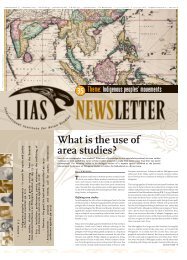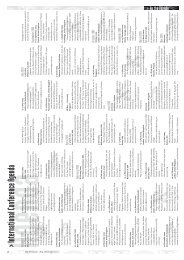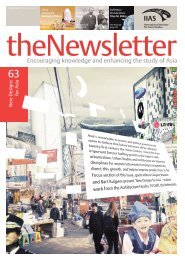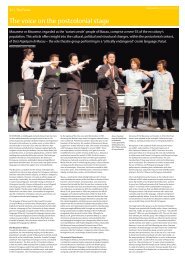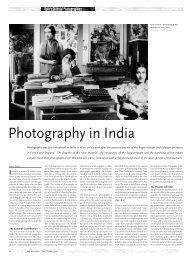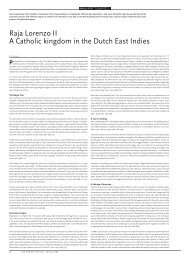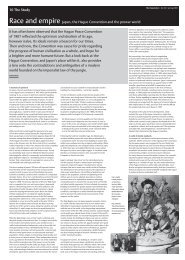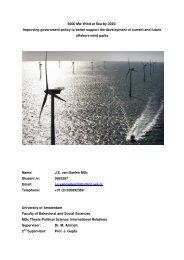Sex, love and revolution - IIAS
Sex, love and revolution - IIAS
Sex, love and revolution - IIAS
You also want an ePaper? Increase the reach of your titles
YUMPU automatically turns print PDFs into web optimized ePapers that Google loves.
P O R T R A I T<br />
One of the ways in which the People’s Republic of China (PRC) <strong>and</strong> the Communist Party (CCP) defined itself was through propag<strong>and</strong>a<br />
art. Throughout its long history, the Chinese political system has used the arts to present <strong>and</strong> spread correct behaviour <strong>and</strong> thought.<br />
Literature, poetry, painting, stage plays, songs <strong>and</strong> other artistic forms were produced to entertain, but they also had to educate the people<br />
in what was considered right <strong>and</strong> wrong.<br />
‘Life as it ought to be’: propag<strong>and</strong>a art of the PRC<br />
Stefan L<strong>and</strong>sberger<br />
In the PRC, propag<strong>and</strong>a art gave concrete expression to the abstract<br />
policies <strong>and</strong> the many different gr<strong>and</strong>iose visions of the future that the<br />
CCP entertained. In a country with as many illiterates as China had in the<br />
1940s <strong>and</strong> 1950s, visualising abstract ideas worked especially.<br />
The most talented artists were mobilised to design posters. Many of them<br />
had been commercial designers <strong>and</strong> were quickly co-opted. The idealised<br />
images not only showed ‘life as it really is’, but also ‘life as it ought to be’,<br />
stressing the positive <strong>and</strong> glossing over anything negative. Original works<br />
of art were reproduced in journals <strong>and</strong> magazines. Large posters could<br />
be seen in the streets, in railway stations <strong>and</strong> other public spaces; the<br />
smaller ones were distributed through the network of the Xinhua (New<br />
China) bookshops for mass consumption; some were even turned into<br />
postage stamps.<br />
Posters could be produced cheaply <strong>and</strong> easily. They were widely available<br />
<strong>and</strong> could be seen everywhere. And they provided an excellent way to<br />
bring some colour to the otherwise drab places where most people lived.<br />
Posters reached even the lowest levels of society: multicoloured posters<br />
adorned not only offices <strong>and</strong> factories, but houses <strong>and</strong> dormitories as well.<br />
Most people liked the posters for their colours, composition <strong>and</strong> visual<br />
contents, <strong>and</strong> did not pay too much attention to the political message.<br />
The contents of the posters were largely defined by the themes of politics<br />
<strong>and</strong> economic reconstruction that were dominant after 1949. Hyper-realistic<br />
ageless, larger-than-life peasants, soldiers, workers <strong>and</strong> youngsters in<br />
dynamic poses peopled the images. They pledged allegiance to the Communist<br />
cause, or obedience to Chairman Mao Zedong, or were engaged<br />
in the glorious task of rebuilding the nation. Most posters glorified work<br />
<strong>and</strong> personal sacrifice for the greater well-being. They paid little attention<br />
to the personal <strong>and</strong> private dimensions of the people’s lives.<br />
Forging ahead courageously while following the great leader Chairman Mao. Publisher: Shanghai renmin meishu chubanshe, collective work. April 1969. 72 x 106,5cm.<br />
Collectie IISG<br />
painters, woodcutters worked separately from traditional painters, <strong>and</strong><br />
propag<strong>and</strong>a posters artists were at the bottom of the hierarchy. Artists<br />
maintain that art can only be called propag<strong>and</strong>a art when it contains one<br />
or more politically inspired slogans. Some of the posters indeed do have<br />
explicit political or propag<strong>and</strong>istic contents, while others do not. Similarly,<br />
some contain one or more politically inspired slogans, but not all of them<br />
do.<br />
But in my discussions with various artists <strong>and</strong> designers, many insisted<br />
that they themselves had mixed up the fine distinctions between the various<br />
styles in the days of the Great Leap Forward <strong>and</strong> the Cultural Revolution,<br />
when all art had to have propag<strong>and</strong>a value.<br />
New view in the rural village.<br />
Designer: Xin Liliang. 1953, Sanyi<br />
Printers. 53,5 x 77,5cm. Collection<br />
International Institute for Social<br />
History.<br />
In the early 1950s, the printing industry was nationalised <strong>and</strong> a few large<br />
producers of propag<strong>and</strong>a posters emerged. They included the People’s<br />
Fine Arts Publishing House in Beijing <strong>and</strong> the Shanghai People’s Fine<br />
Arts Publishing House. Until well into the 1980s, these publishers would<br />
dominate the field. Other specialised publishing houses put out materials<br />
as well. The Inner Mongolian People’s Publishing House, for example,<br />
specialised in (bi- <strong>and</strong> multi-lingual) posters about <strong>and</strong> for national<br />
minorities, while posters devoted to sports <strong>and</strong> physical education were<br />
published by the Sports Publishing House in Beijing. During the Cultural<br />
Revolution, poster production was largely decentralised. In the 1980s, the<br />
predominance of the Beijing <strong>and</strong> Shanghai establishments eroded <strong>and</strong><br />
other publishers took over.<br />
Propag<strong>and</strong>a posters have been around for more than six decades, <strong>and</strong><br />
as a result, they form a body of materials that is incredibly rich in<br />
information. They are important for what they show, but maybe even<br />
more for what they fail to pay attention to…<br />
Art <strong>and</strong> propag<strong>and</strong>a posters<br />
What exactly is a propag<strong>and</strong>a poster? According to many artists <strong>and</strong><br />
designers the term propag<strong>and</strong>a art cannot be used indiscriminately to<br />
cover all art that has been produced in the PRC. In their opinion, poster art<br />
should be divided into discrete genres such as New Year prints (nianhua),<br />
oil paintings (youhua), gouache (shuifenhua), woodcuts (mubanhua), traditional<br />
paintings (Zhongguo hua), propag<strong>and</strong>a posters (xuanchuan hua),<br />
etc. This classification is inspired largely by the way the arts sector was<br />
ordered bureaucratically in China. Water colourists did not mix with oil<br />
The roots of Chinese propag<strong>and</strong>a art<br />
From its inception, the CCP had been imbued with the cultural iconoclasm<br />
of the May Fourth New Culture Movement (1919-1921). During<br />
the First United Front with the Nationalist Party (Guomindang, GMD) in<br />
1924-1927, the CCP set out to replace ‘old culture’ <strong>and</strong> to control public<br />
opinion through propag<strong>and</strong>a, agitation <strong>and</strong> political education, employing<br />
forms <strong>and</strong> techniques originating in the Soviet Union. In the Jiangxi<br />
Soviet (1931-1934), the CCP further developed its strategy of using the arts<br />
to educate the people in both literacy <strong>and</strong> loyalty to the Party. 1<br />
In Yan’an, where the CCP found itself after the Long March (1934-1935),<br />
the use of art as a catalyst for change was further refined. This was to<br />
counter GMD-propag<strong>and</strong>a, but also to neutralise the propag<strong>and</strong>a of the<br />
Japanese that had invaded China in 1937. The latter justified the Japanese<br />
military presence <strong>and</strong> warned against co-operating with either Nationalists<br />
or Communists. In 1942, Mao Zedong made it clear that arts had to<br />
serve politics, in the form of the dem<strong>and</strong>s made by the CCP. 2 In order to<br />
accommodate <strong>and</strong> reach the largely illiterate peasants, the Party decided<br />
to address them in the traditional medium of New Year prints.<br />
These ‘new’ New Year prints were based on calendar posters, traditional<br />
painting <strong>and</strong> popular block prints. They employed old visual elements<br />
with new contents <strong>and</strong> manipulated symbols used in traditional popular<br />
culture <strong>and</strong> traditional values. The peasantry responded positively to their<br />
familiar visual idiom; they liked their nianhua realistic, as long as their<br />
portrayal of events was a little more beautiful than actual reality.<br />
2 6 I I A S N E W S L E T T E R # 4 8 S u m m e r 2 0 0 8



